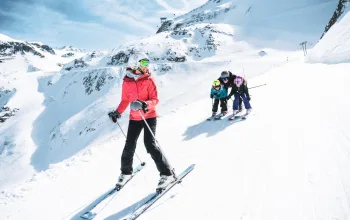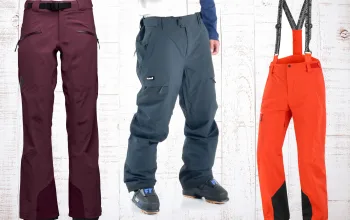Following the pandemic, it’s fair to say that there weren’t quite as much newness as we typically saw in the run-up to winter, but these brands are now making up for lost time, harnessing the potential of space-age materials, creating boots designed for back country ascents as well as descents, and rolling out BOA systems – ratchet-style mechanisms which have been used on snowboard boots for years. Here are the best ski boots for winter 2023/24.
Check out our comprehensive guide on how to buy ski boots below.
The Best Ski Boots 2023
- The Best Ski Boots 2023
- Dynafit Tigard 130
- Atomic Hawx Ultra 110
- K2 Recon 120
- Atomic Hawx Ultra 95
- K2 Anthem 85 W
- Salomon S/Pro 80 W
- Atomic Hawx Ultra XTD 130 BOA
- Rossignol Evo 70
- Atomic Hawx Prime XTD 120
- Head Edge Lyt 110
- Best of the rest
- Tecnica Cochise 110
- K2 Recon 120 BOA Men's Ski Boots 2024
- Dalbello Panterra 75 W
- Scarpa F1 LT
- Salomon S/Pro Supra Boa 120 2024
- Ski boot buyer's guide
Dynafit Tigard 130
Best backcountry ski boots

Fit: Regular
Price: £700
Weight: 1550g
Flex: 130
Dynafit’s Tigard 130 boots have been designed for backcounty skiers who love the ascent as much as the descent. In other words, they’re incredibly light and packed with features designed to make uphill hikes a breeze. When in uphill mode, a cuff rotation of 70 degrees allows for more freedom of movement, while the brilliant Gripwalk sole on these boots (which are crampon friendly) provides great traction. When it’s time to head downhill, the Dynafit Hoji Lock System, which unifies the boot cuff and shell via an interlocking mechanism, provides unbeatable control and stability, and an overlap construction – inspired by traditional alpine ski boot design – hugs the foot in a way which allows for effortless power transition.
Buy Dynafit Tigard 130: £700 at Dynafit
Atomic Hawx Ultra 110
Best men’s all mountain ski boot

Fit: Narrow
Price: £330
Weight: 1700g
Flex: 110
The Hawx range of ski boots was revamped back in 2021, turning it into a fantastic choice for advanced skiers with narrow feet. Impressively lightweight, the boots’ Power Shift function adjusts forward lean so you can tailor your attack to the terrain, while the Energy Backbone is the perfect partner for the Prolite construction. It’s a double act which helps to keeps the weight low while cranking up the stiffness for unbeatable control and power. The finishing touches of the Memory Fit shell and Memory Fit 3D Gold Liner allow a custom fit suited to a variety of foot shapes.
Buy Atomic Hawx Ultra 110: £240 at Ellis Brigham <SALE DEAL>
K2 Recon 120
Best men’s all mountain ski boot

Fit: Medium
Price: £400
Weight: 1650g
Flex: 120
A lightweight boot designed for heavy duty skiing sessions, the K2 Recon 120 delivers fantastic control and precision while keeping the weight low. This weight is the result of various innovations, including the presence of various materials for the shell – more specifically, four areas with completely different levels of stiffness. The result isn’t just a great boot for skiers who prefer to stick to the piste, but one with enough flex for adventures in soft backcountry snow as well as more varied terrain. As with most of K2’s newer boots, the shell and the liner can be custom moulded for a bespoke fit.
Buy K2 Recon 120: £255 at Ellis Brigham <SALE DEAL>
Atomic Hawx Ultra 95
Best women’s all mountain ski boot

Fit: Narrow
Price: £320
Weight: 1510g
Flex: 95
Atomic makes the bold claim that the Hawx Ultra 95’s are their lightest boots ever, and we suspect they’re correct. A less aggressive flex means they’re perfect for intermediate to advanced skiers keen on technical all-mountain skiing adventures. Their low weight – each boot weighs just 1510g - is down to Prolite technology, which carefully distributes material thickness without adding unnecessary weight. This, according to Atomic, means a 25 per cent weight reduction. As with other boots in the extensive Hawx range, the shell and liner can be heat moulded, and the overall low volume design is specifically designed for the female anatomy, resulting in a better fit and all-day comfort.
Buy Atomic Hawx Ultra 95: £228 at Ellis Brigham <SALE DEAL>
K2 Anthem 85 W
Best women’s all mountain ski boot

Fit: Medium
Price: £265
Weight: 1560g
Flex: 85
A brilliant choice for intermediate female skiers who want cutting edge tech without the discomfort, the K2 Anthem offers dialled-back stiffness but with all the bells and whistles (including a co-injected ‘Y' shaped support) commonly found in men’s boots. A Prolite shell keeps weight low and is custom moldable, while the heat-moldable liner is slightly softer than more technical boots, which means better comfort levels and fewer niggling pressure points and hotspots. In another nod to comfort, the instep area of the boot has been softened, enabling easy access. The custom-engineered has been designed with women’s (generally more slender) calf profiles in mind, too.
Buy K2 Anthem 85 W: £300 at K2snow.com
Salomon S/Pro 80 W
Best beginners’ ski boot

Fit: Women Medium
Price: £270
Weight: 1620g
Flex: 80
For women seeking a comfortable boot that won’t disappoint on all-day skiing sessions, the Salomon S/Pro 80 is well worth considering. They’re ideal for skiers keen to perfect their technique without compromising on comfort, and Salomon’s years of ski boot expertise have been put to good use,, most notably with the fibreglass Core Frame and Sense Amplifier, which combine to give excellent edge to edge transfer and good responsiveness to boot. The liner is custom-moldable and entirely seamless – something which helps distribute pressure and minimise the risk of aches and pains.
Buy Salomon S/Pro 80 W: £134.95 at Absolute Snow <SALE DEAL>
Atomic Hawx Ultra XTD 130 BOA
Best BOA boot

Fit: narrow
Price: £755
Weight: 1810g
Flex: 130
If you’re getting the sense BOA is going to be a thing for ski boots this year, you’re probably right. The XTD range of ski boots has been designed for those partial to ski touring, although these bad boys are probably the ones most suited to downhill fun. The positioning of Atomic’s BOA system allows it to clamp down on the boot with consistently-distributed pressure, and we loved the way the dial is designed to pop off on impact (putting it back on is easy, too). But the BOA isn’t the only thing to get excited about with these boots – there’s extra consistency thanks to a fully PU (polyurethane) shell (previously, a mix of materials was used) and a new liner with a corrugated flex zone for smoother flexing. Activating walk mode is easier, too – simply loosen the two screws and flip the lock mode lever.
Hawx Ultra XTD: £700 at Ellis Brigham
Rossignol Evo 70
Best beginners’ ski boot

Fit: Men/Relaxed
Price: £170
Weight: 1670g
Flex: 70
The Rossignol Evo 70 does what an entry level ski boot should – it ditches the bells and whistles in favour of a wallet-friendly ski boot perfect for beginner skiers investing in their first ski boot. Rossignol claims these boots have the softest flex and widest last (a generous 104mm), the former aspect enhanced by the three-buckle design. The roomy fit allows the perfect amount of wiggle room, and the T4 liners provide a basic level of customisation (we’d suggest purchasing a separate heat-moldable liner for added comfort). In summary? A great starter boot at a wallet-friendly price.
Buy Rossignol Evo 70: £160.22 at Amazon.co.uk
Atomic Hawx Prime XTD 120
Best for backcountry ski touring

Fit: Medium
Price: £500
Weight: 1,873g
Flex: 120
The Atomic Hawx Prime XTD boots have been winning awards since their release in 17/18, and unsurprisingly the range has continued growing to the present day. The Atomic Hawx Prime XTD 120 is based on the Ultra XTD, and welds together the all-mountain capability of Hawx with the touring ability of the Backland Free/Lock 4.0 ski-to-walk mechanism - essentially Hawx boots with walk mode. The result? excellent downhill performance without too much compromise on the way up.
Buy Atomic Hawx Prime XTD 120: £430 at Snow + Rock
Head Edge Lyt 110
Best ski boots for wide feet

Fit: Relaxed
Price: £300
Weight: 1781g
Flex: 110
The Edge LYT established itself several seasons ago as being a generous fitting boot for intermediate to advanced skiers, and underwent a complete revamp in 2022. The Hi-Top Tech creates direct contact between the boot’s tongue and shell which allows for immediate energy and power transfer from the skier to the ski, while the Smart Frame shell is lightweight, but still manages to improve dynamic rebound. The liner has been upgraded to a Liquid Fit liner, which ensures a perfect fit around the ankles and heels.
Buy Head Edge Lyt 110: £227.50 at Brigham Ellis <SALE DEAL>
Best of the rest
Tecnica Cochise 110

Fit: Men/Medium
Price: £480
Weight: 1750g
Flex: 110
A familiar sight in the hybrid ski boot category (thanks to a decade of iteration), the men’s Cochise delivers all-round value in a lightweight and medium-stiff boot that’s well-balanced in terms of on and off-piste performance. The T-Ride walk mechanism does a solid job of bridging the gap between resort and backcountry, offering a 75° range of motion. The light weight (1750g) is noticeable on the hill, especially on ascent, with its manoeuvrability being aided by the Carbon Co-injected Back Spine construction.
TECNICA COCHISE 110 FULL REVIEW
Buy Tecnica Cochise 110: £429.95 at Outdoor XL
K2 Recon 120 BOA Men's Ski Boots 2024
Best ski boot for customisation potential
Fit: medium
Price: £550
Weight: 1580g
Flex: 120
Yep, another BOA boot – this time from K2. As with other BOA boots, it’s not simply the presence of the new ratchet-style mechanism which is new. There’s a redesigned lower cuff and the entire shell has been redesigned to allow for a more precise fit around the toes. You can also expect seriously impressive heel hold courtesy of internal and external J-bars and customisable heel inserts designed to allow additional fine-tuning. And, of course, there’s K2’s heat-moldable liner. In a nutshell, these BOA ski boots knock others out of the ballpark when it comes to the potential for customisation.
K2 Recon 120: £480.73 at Amazon.co.uk
Dalbello Panterra 75 W

Fit: Women/Medium
Price: £295
Weight: 1840g
Flex: 75
This female-specific boot is a great option for skiers seeking fantastic comfort and flex, but they also offer brilliant support, thanks to the three-piece cabrio design. A soft flex rating is an unexpected – but very welcome – addition for boots at this price point and the light DB Hyperlite construction emphasises day-long comfort rather than any aspirations to aggressive riding. The Ski & Hike mechanism gives a decent 33 degrees of motion, and Gripwalk soles keep you upright on icy walks. Both liner and shell can be thermo customised for a more bespoke fit.
DALBELLO PANTERRA 75 FULL REVIEW
Buy Dalbello Panterra 75 W: £290.00 at Snow and Rock
Scarpa F1 LT

Fit: Men/Relaxed
Price: £560
Weight: 990g
Flex: 70
If it’s likely you’ll be getting to your next descent on foot, rather than ski lift, these boots could be for you. They’re incredibly light – each boot weighs just 990g - and there’s plenty of room for ankle movement, due to the softened "flex zone" behind the achilles. That said, the downhill performance isn’t quite up to a resort boot, but if you’re looking for a boot to transform steep hikes, you’ll struggle to beat the Scarpa F1 LT.
Buy Scarpa F1 LT: £503.90 at Snowleader
Salomon S/Pro Supra Boa 120 2024
Best ski boot for wide feet

Fit: Wide
Price: £520
Weight: 1880g
Flex: 120
This is Salomon’s first ski boot with BOA technology. Comfort is clearly a priority – an internal Sensifit mesh with different densities in different areas ramps up comfort and ensures more efficient energy transmission, while the thermoformable latex-foam liner’s elastic strap provides more opportunities for quick customisation. The placement of the BOA mechanism, which replaces the second buckle, works with the EXOWRAP ecosystem to hold the foot securely and comfortably in place, creating a boot which feels cohesive, comfortable and ready for anything.
Buy Salomon S/Pro Supra BOA 120: £520 at Ellis Brigham
Ski boot buyer's guide
Now more than ever, the sheer number of ski boot designs can make finding the right one a minefield. We’ve cut through the jargon to come up with the ultimate guide to finding the right footwear.
Best Ski Boots 2023 sizing and fitting
Mondo, or mondopoint sizes are a universal measuring system for ski boots, originally intended to ease confusion. Very simply, it’s the length of your foot in centimetres. With your mondo size in hand, picking a boot should be child’s play - but there are still couple of factors to bear in mind.
Firstly, your skill level will dictate just how tight you want your boots - bigger and looser if you’re planning on annual ski holidays at your favourite resort, through to a tighter fit for advanced skiers who prioritise control. The latter is much more likely to be less comfortable for long periods thanks to pressure points and hotspots, so there’s a balance to be struck here.
Although it’s worth taking the time to find a ski boot which fits well and feels comfortable, ski boots can be tweaked in a myriad of ways by experienced fitters. The most common tweaks are to the liners, which are now made in a wide range of materials. Most ski boot manufacturers now offer customers the chance to get their liners heat-moulded, and in recent years a number of brands have launched standalone heat-moldable liners, which can be added after you’ve purchased your boots.
Modifying the shell of the boot without compromising its structural integrity is often done with infrared heat and suction, but can also include grinding, punching, shaping and stretching. Overall, it’s vital to pick an experienced fitter to take this process on, not only to get a good fit in the first place, but also to have an expert on hand for future tweaks as the boots (and your feet) bed in and change through use – after all, boots will ‘pack out’ (expand in size) to a certain extent after a few runs. Most resorts will have boot fitting experts on hand, and closer to home larger UK retailers such as Snow and Rock and Ellis Brigham’s SureFit programme, or specialists such as ProFeet are all good choices.
Best Ski Boots 2023 ski boot types
Alpine ski boots are usually your starting point if you’ve learned to ski on a piste. They’re essentially stiff outer shells with comfortable liners, designed for optimum control and performance when skiing downhill. They’ve got a fixed spine at the back of the boot, which encourages optimal skiing position – although this stiffness means they can quickly become uncomfortable when you’re walking.
Alpine ski boots can be divided into five main categories:
Piste ski boots cover the broad ground between beginner hire boots and more technical, stiff performance boots which incorporate various race-style technologies. They tend to focus on comfort and styling, ideal for ski holidays and (in reality) the majority of skiers.
Race ski boots take the piste boot one step further, discarding comfort and warmth in favour of stiffness and control. These boots are likely to be packed full of technical features, but are uncomfortable to wear for prolonged periods, simply because they’re incredibly tight-fitting and offer minimal resistance to the cold.
Freestyle ski boots are built for jumps and rails, so can not only take a beating, but have a fair amount of flex in them to soak up the impacts.
Freeride ski boots set out to tackle all kinds of mixed terrain, so they typically have more give, in order to allow them to deal with sudden changes in snow conditions. That said, they’ll often have a stiffer lateral flex to provide the extra control freeriders need.
Alpine touring (AT) ski boots can vary hugely, which is hardly surprising given that they’re designed to blend Alpine-style downhill prowess with the ability to unlock the ankle for long hikes, too. Increasingly sophisticated, there are many shades of AT boot, and features vary hugely – you’ll find boots with different binding compatibility, greater or lesser ankle movement, and varying weights to trade stiffness for lightness. Our top tip? Take the time to think about how much time you’ll spend skinning uphill and skiing downhill and look for a boot with the features you feel will be of most value, whether it’s a low weight for uphill ascents or extra stiffness for brilliant control on descents.
Ski touring boots
Touring boots take that ‘all mountain’ concept one step further, building in a switch or lock which lets you choose ski mode (stiff, ankle cuff locked), or touring, where the cuff of the boot can move, allowing much easier movement, especially when skinning uphill. For obvious reasons, weight makes a big difference when you’re carrying it uphill, so touring boots tend to be lightweight, often relying on space-age materials which push up the price tag.
There was a time when ski touring boots struggled to address balancing act between uphill performance and downhill ability, with the latter traditionally losing out, but that’s (thankfully) no longer the case. Today, touring boots blur the lines between boots designed for AT, ski touring and ski mountaineering.
How to choose your ski boots: Flex
Ski boots’ flex numbers, which range between 60 and 130, indicate how much give the boot has. The lower the flex number the softer, suppler the boot. Freestyle and all-mountain boots tend to have a lower flex as they’re more forgiving and give you the ability to work with your skis better. The harder and stiffer the boot, the harder you’ll need to work to get the efficiency and the ability you’ll need for fast, aggressive skiing, hence the very high flex on racing boots. Touring boots are a hybrid of flexes, and rely on walk /ski modes to offer best of both worlds. This mechanism makes the boot more flexible for walking uphill but allows you to ramp up the stiffness on those high speed descents.
How to choose your ski boots: Last
Knowing the width of your foot can mean the difference between a comfortable ski boot and an incredibly painful blister-inducing one. Working out your width is simple. Wearing a sock, measure the width of the outline of your foot at its widest point in millimetres. This will tell you whether you need a narrow boot or a wide one. Generally, anything below 100 mm is considered narrow while anything above 104 mm is considered wide. Ski boot brands tend to veer towards one or the other, so it is vital you go for a boot that encapsulates your foot comfortably.




















